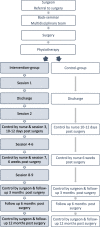The effect of graded activity and pain education (GAPE): an early post-surgical rehabilitation programme after lumbar spinal fusion-study protocol for a randomized controlled trial
- PMID: 32933571
- PMCID: PMC7493936
- DOI: 10.1186/s13063-020-04719-y
The effect of graded activity and pain education (GAPE): an early post-surgical rehabilitation programme after lumbar spinal fusion-study protocol for a randomized controlled trial
Abstract
Background: Patients with chronic low back pain undergoing lumbar spinal fusion (LSF) are physically inactive and thereby at risk of poor health. Barriers to being physically active need to be acknowledged in post-surgical rehabilitation. The primary objective of this randomized controlled trial (RCT) is to examine the effect of an early active intervention consisting of graded activity and pain education (GAPE) on sedentary behaviour in a population of patients undergoing LSF. The secondary objective is to examine the effect of GAPE on disability, pain, fear of movement, self-efficacy for exercise, and health-related quality of life.
Methods: The study is an RCT planned to include 144 patients undergoing LSF at 1-2 levels for low back pain caused by degeneration of the lumbar spine. The patients will be randomly assigned to receive either usual care or usual care plus GAPE. GAPE consists of nine individual physiotherapist-guided sessions over a 10-week period. The overall purpose is to reduce sedentary behaviour, by educating the patient about pain and, based on a cognitive behavioural perspective, gradually strengthen the patient's self-efficacy to be physically active and reduce fear of movement. The physiotherapist will plan the intervention in collaboration with the patient. Based on a semi-structured interview and observations of the patient in their home, they will set individually functional goals. The primary outcome will be a reduction in sedentary behaviour, measured by an accelerometer at baseline (pre-surgery) and at 3 and 12 months post-surgery. Secondary outcomes will include disability, pain, fear of movement, self-efficacy for exercise, and quality of life. Secondary outcome data will be collected at baseline (pre-surgery) and at 3, 6 and 12 months post-surgery.
Discussion: We hypothesize that, compared with the "usual care group", GAPE will primarily lead to a significant reduction in sedentary behaviour, and secondarily a reduction in disability, pain intensity, and fear of movement; further, it will increase the patient's self-efficacy for exercise and quality of life.
Trial registration: www.clinicaltrials.gov NCT04103970 , Registered on 24 September 2019.
Keywords: Behaviour; Low back pain; Rehabilitation; Surgery.
Conflict of interest statement
The authors declare that they have no competing interests.
Figures
Similar articles
-
The Effect of Graded Activity and Pain Education After Lumbar Spinal Fusion on Sedentary Behavior 3 and 12 Months Postsurgery: A Randomized Controlled Trial.Arch Phys Med Rehabil. 2024 Aug;105(8):1480-1489. doi: 10.1016/j.apmr.2024.04.005. Epub 2024 Apr 27. Arch Phys Med Rehabil. 2024. PMID: 38685291 Clinical Trial.
-
Use of the PREPARE (PREhabilitation, Physical Activity and exeRcisE) program to improve outcomes after lumbar fusion surgery for severe low back pain: a study protocol of a person-centred randomised controlled trial.BMC Musculoskelet Disord. 2016 Aug 18;17(1):349. doi: 10.1186/s12891-016-1203-8. BMC Musculoskelet Disord. 2016. PMID: 27538757 Free PMC article. Clinical Trial.
-
Randomized controlled trial of postoperative exercise rehabilitation program after lumbar spine fusion: study protocol.BMC Musculoskelet Disord. 2012 Jul 20;13:123. doi: 10.1186/1471-2474-13-123. BMC Musculoskelet Disord. 2012. PMID: 22817607 Free PMC article. Clinical Trial.
-
Description and design considerations of a randomized clinical trial investigating the effect of a multidisciplinary cognitive-behavioural intervention for patients undergoing lumbar spinal fusion surgery.BMC Musculoskelet Disord. 2014 Mar 3;15:62. doi: 10.1186/1471-2474-15-62. BMC Musculoskelet Disord. 2014. PMID: 24581321 Free PMC article. Clinical Trial.
-
Evaluation and Rehabilitation after Adult Lumbar Spine Surgery.J Clin Med. 2024 May 15;13(10):2915. doi: 10.3390/jcm13102915. J Clin Med. 2024. PMID: 38792457 Free PMC article. Review.
Cited by
-
The effect of psychologically informed practice with behavioural graded activity in cancer survivors: systematic review and meta-analysis.J Cancer Surviv. 2024 Jun;18(3):854-899. doi: 10.1007/s11764-022-01270-4. Epub 2023 Jan 26. J Cancer Surviv. 2024. PMID: 36701101 Free PMC article.
-
Follow-Up of a Case of Dopamine-Mediated Yawning-Fatigue-Syndrome Responsive to Opioids, Successful Desensitization via Graded Activity Treatment.Neurol Int. 2021 Feb 25;13(1):79-84. doi: 10.3390/neurolint13010008. Neurol Int. 2021. PMID: 33668800 Free PMC article.
References
-
- GBD 2015 Disease and Injury Incidence and Prevalence Collaborators. Global, regional, and national incidence, prevalence, and years lived with disability for 310 diseases and injuries, 1990-2015: a systematic analysis for the Global Burden of Disease Study 2015. Lancet. 2016;388(10053):1545–602. - PMC - PubMed
-
- Hurwitz EL, Randhawa K, Yu H, Cote P, Haldeman S. The Global Spine Care Initiative: a summary of the global burden of low back and neck pain studies. Eur Spine J. 2018;27(Suppl 6):796–801. - PubMed
-
- Brook MI, Mirza SK, Spina N, Spiker WR, Lawrence B, Brodke DS. Trends in lumbar fusion procedure rates and associated hospital costs for degenerative spinal diseases in the United States, 2004 to 2015. Spine. 2019;44(5):369–376. - PubMed
Publication types
MeSH terms
Associated data
Grants and funding
LinkOut - more resources
Full Text Sources
Medical






